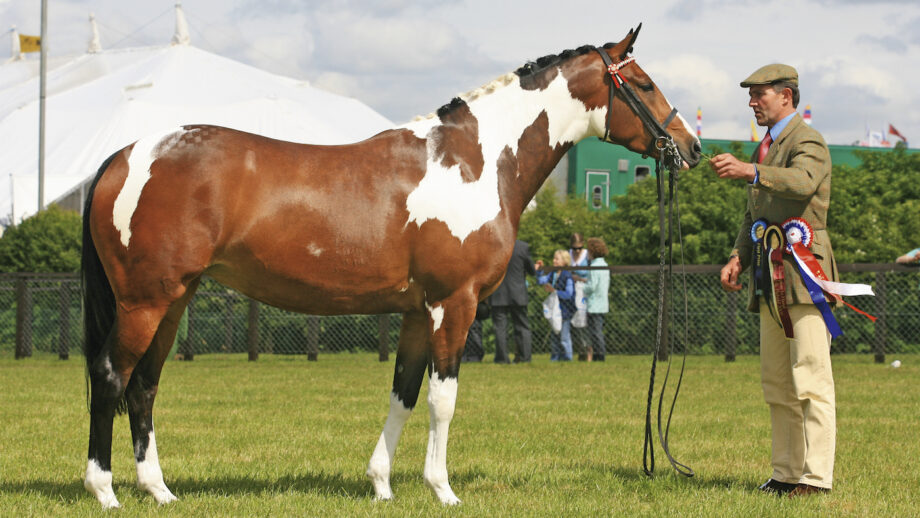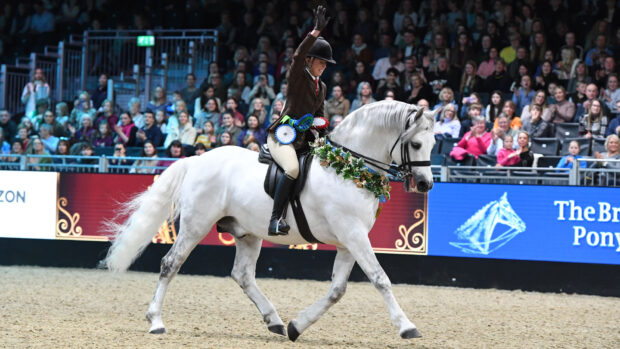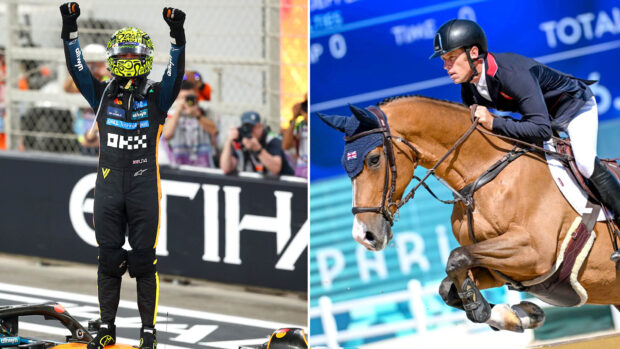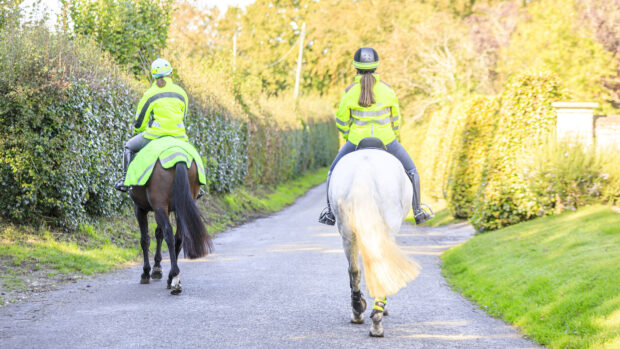Retraining racehorses for showing takes time, patience and repetition. Not all former racehorses are suitable to go on to succeed in the show ring as their second career as only a horse of a certain quality can reach the highest levels in showing. There are, though, many retired racing stars who have gone onto excel in both specific showing classes for former racehorses and in open show horse ranks.
An ex-racehorse can be a popular choice for many riders as they are often readily available and, in lots of instances, can be bought for considerably less money than their unraced counterparts. Buying an ex-racehorse with the intention of it becoming a show horse is a gamble as even though the animal might look the part, their temperament must be right for the job.
There are many opportunities in the showing world for former racehorses and their owners. Most local and county shows schedule retrained racehorse classes, either unaffiliated or affiliated to Retraining of Racehorses (RoR) or SEIB Racehorse to Riding Horse (R2R).
The main showing finals for ex-racehorses are held at Horse of the Year Show (HOYS) in October, and at the Hickstead Derby meeting in July. The RoR national championships is also a major occasion for former racehorses with the overall supreme being one of the most coveted titles on the circuit. There are also specific classes for amateur and home-produced riders who own racehorses, including at the London International Horse Show. H&H created this extensive guide on showing ex-racehorses.
How long it takes a former racehorse to adapt to showing will depend on the horse’s temperament, breeding and racing history, but sympathetic and well-thought-out training can also go a long way in ensuring they enjoy success in another sphere.
Retraining racehorses for showing: 9 key areas
H&H speaks to two of the circuit’s most established show horse specialists who have won titles with former racehorses in recent years to find out how they approach retraining racehorses for showing.
Jo Bates is a show horse specialist with many championships to her name. She is one of the circuit’s most consistent retrained racehorse producers, having guided several of these horses to the top of their game in the show ring. Jo was HOYS R2R champion aboard Grandeur in 2019, and she is the producer of Katie Dashwood’s history-making ex-racer Minella Rebellion, who was R2R champion at HOYS in his first season before he was crowned riding horse of the year in 2023, becoming the only former racehorse to achieve wins in both open and R2R divisions at HOYS. He is also a multi-RIHS winner. Other stars Jo has ridden include Slightly Trendy and Simbad.

Jo Bates produced Katie Dashwood’s versatile champion, the retrained racehorse Minella Rebellion. Credit: Peter Nixon
Kirstine Douglas is a leading show horse producer who is based in Dumfries. Her current top middleweight hunter contender, Rich Man Poor Man, was formerly in training with Philip Kirby. He is a dual weight and RoR champion, having stood supreme hunter and supreme RoR at the Royal Highland, and having been to HOYS under both guises.

Kirstine Douglas with Rich Man Poor Man, who took to his new career fantastically well, excelling as a top-class middleweight hunter. Credit: Grossick Racing
1. Time and patience
{"content":"PHA+Sm8gbWFpbnRhaW5zIHRoYXQgdGhlIHR3byBtYWluIGluZ3JlZGllbnRzIHRoYXQgZ28gaW50byByZS10cmFpbmluZyBhcmUgdGltZSBhbmQgcGF0aWVuY2UuPC9wPgo8cD7igJxHaXZlIHlvdXJzZWxmIHRoZSBzbWFsbGVzdCBvZiBnb2FscyB0byBiZWdpbiB3aXRoLOKAnSBKbyBzdGFydHMuIOKAnFRoZXkgY2FuIGdyb3cgaW50byBiaWcgZHJlYW1zIGJ1dCBpZiB5b3UgZ2V0IHRvbyBhbWJpdGlvdXMgdG9vIHNvb24sIHlvdeKAmWxsIGxpa2VseSBmcnkgYW4gZXgtcmFjZWhvcnNl4oCZcyBicmFpbi4gWW91IG5lZWQgdG8gZ2l2ZSB0aGVtIGNvbmZpZGVuY2UgYW5kIHRydXN0IGluIHlvdSwgc28gdGhleSBrbm93IHlvdeKAmXJlIGdvaW5nIHRvIGhvbGQgdGhlaXIgaGFuZCBhbmQgZ3VpZGUgdGhlbSB0aHJvdWdoIGFueSBzaXR1YXRpb24uIFRob3JvdWdoYnJlZHMgYXJlIHN1Y2ggcGVvcGxlIHBsZWFzZXJzLCBhbmQgdGhleSBuZWVkIHRvIGtub3cgdGhhdCB5b3XigJlyZSB0aGVyZSBmb3IgdGhlbS7igJ08L3A+CjxkaXYgY2xhc3M9ImFkLWNvbnRhaW5lciBhZC1jb250YWluZXItLW1vYmlsZSI+PGRpdiBpZD0icG9zdC1pbmxpbmUtNSIgY2xhc3M9ImlwYy1hZHZlcnQiPjwvZGl2PjwvZGl2Pgo8cD5LaXJzdGluZSBhZ3JlZXMgdGhhdCBydXNoaW5nIGEgaG9yc2UgcmFyZWx5IHByb2R1Y2VzIHRoZSBpbnRlbmRlZCByZXN1bHRzLjwvcD4KPHA+4oCcSSBuZXZlciBydXNoIGFueSBzaG93IGhvcnNlIHRvIGdldCB0aGVtIG91dCBpbnRvIHRoZSByaW5nIGFuZCBqdXN0IGJlY2F1c2UgdGhlIHNob3dzIGhhdmUgc3RhcnRlZCBkb2VzbuKAmXQgbWVhbiB5b3UgaGF2ZSB0byBydXNoIHRvIGdldCBvdXQs4oCdIHNoZSBjb25maXJtcy4g4oCcSSBtaWdodCBzcGVuZCB0aW1lIG9uIHRoZSBncm91bmQgYmVmb3JlIGRyb3BwaW5nIGEgaG9yc2UgZG93biBmb3IgdGltZSB0byBtYXR1cmUsIHRoZW4gSeKAmWxsIHBpY2sgdGhlbSBiYWNrIHVwIGFnYWluLiBJZiB0aGV54oCZcmUgc3RpbGwgbm90IHJlYWR5LCBJ4oCZbGwgZ2l2ZSB0aGVtIGV2ZW4gbW9yZSB0aW1lIHRvIGRldmVsb3AuIEZvciByYWNlaG9yc2VzLCB0aGlzIGltcGxpZXMgdG8gbWVudGFsIG1hdHVyaXR5IGFzIG11Y2ggYXMgcGh5c2ljYWwgbWF0dXJpdHkuIElmIHlvdeKAmXJlIHBhdGllbnQsIGEgaG9yc2Ugd2lsbCBwYXkgeW91IGRpdmlkZW5kcyBpbiB0aGUgbG9uZyBydW4u4oCdPC9wPgo8aDM+Mi4gSXMgbXkgZm9ybWVyIHJhY2Vob3JzZSByaWdodCBmb3IgdGhlIHNob3cgcmluZz88L2gzPgo8cD7igJxUaGUgbW9tZW50IEkgZmlyc3Qgc2l0IG9uIHRoZSBob3JzZSBJIG11c3QgdGhpbmsg4oCYeWVzLCBJIGNhbiBkbyBzb21ldGhpbmcgd2l0aCB0aGlz4oCZIOKAkyBpdOKAmXMgYW4gaW5uYXRlIGZlZWxpbmcs4oCdIEpvIHNheXMuIOKAnFRoZSBob3JzZSBtdXN0IGxldCB5b3UgcmlkZSB0aGVtLCBhbmQgdGhleSBtdXN0IGZlZWwgY29tZnkgYW5kIG1hbm9ldXZyYWJsZS7igJ08L3A+CjxwPk9uZSBvZiBKb+KAmXMgbW9zdCBsb3ZlZCBmb3JtZXIgcmFjZWhvcnNlcyB3YXMgWXZvbm5lIEphY3F1ZXPigJkgZ3JleSBnZWxkaW5nIEdyYW5kZXVyLiBEdXJpbmcgaGlzIHJhY2luZyBjYXJlZXIgaGUgd29uIGFsbW9zdCDCozYwMCwwMDAgaW4gcHJpemUgbW9uZXkuIEFzIHdlbGwgYXMgYmVpbmcgb25lIG9mIHRoZSBiaWdnZXN0IHdpbm5lcnMgb24gdGhlIFJvUiBjaXJjdWl0LCBoZSB3YXMgYWxzbyBhIHRvcCBsYXJnZSBoYWNrLCBmaW5pc2hpbmcgc2Vjb25kIGFuZCB0aGlyZCBvbiBoaXMgdmlzaXRzIHRvIEhPWVMuPC9wPgo8ZGl2IGlkPSJhdHRhY2htZW50Xzg4NTgzNCIgc3R5bGU9IndpZHRoOiAxNDEwcHgiIGNsYXNzPSJ3cC1jYXB0aW9uIGFsaWdubm9uZSI+PGltZyBmZXRjaHByaW9yaXR5PSJoaWdoIiBkZWNvZGluZz0iYXN5bmMiIGFyaWEtZGVzY3JpYmVkYnk9ImNhcHRpb24tYXR0YWNobWVudC04ODU4MzQiIGNsYXNzPSJsYXp5bG9hZCBibHVyLXVwIHNpemUtZnVsbCB3cC1pbWFnZS04ODU4MzQiIGRhdGEtcHJvY2Vzc2VkIHNyYz0iaHR0cHM6Ly9rZXlhc3NldHMudGltZWluY3VrLm5ldC9pbnNwaXJld3AvbGl2ZS93cC1jb250ZW50L3VwbG9hZHMvc2l0ZXMvMTQvMjAxNy8wMy9uZXctaGgtcGxhY2Vob2xkZXItMjAweDIwMC5wbmciIGRhdGEtc3JjPSJodHRwczovL2tleWFzc2V0cy50aW1laW5jdWsubmV0L2luc3BpcmV3cC9saXZlL3dwLWNvbnRlbnQvdXBsb2Fkcy9zaXRlcy8xNC8yMDI1LzAzL0hvcnNlTm81MjZfSE9ZU19QTjE5XzEzNzk3OV8zNDg0NTUzOTJfNTg3NDcwNTgyLmpwZyIgYWx0PSJHcmFuZGV1ciwgYSBncmV5IHJldHJhaW5lZCByYWNlaG9yc2UgZXhjZWxsaW5nIGluIHRoZSBzaG93IHJpbmciIHdpZHRoPSIxNDAwIiBoZWlnaHQ9Ijc4OCIgZGF0YS1zaXplcz0iYXV0byIgZGF0YS1zcmNzZXQ9Imh0dHBzOi8va2V5YXNzZXRzLnRpbWVpbmN1ay5uZXQvaW5zcGlyZXdwL2xpdmUvd3AtY29udGVudC91cGxvYWRzL3NpdGVzLzE0LzIwMjUvMDMvSG9yc2VObzUyNl9IT1lTX1BOMTlfMTM3OTc5XzM0ODQ1NTM5Ml81ODc0NzA1ODIuanBnIDE0MDB3LCBodHRwczovL2tleWFzc2V0cy50aW1laW5jdWsubmV0L2luc3BpcmV3cC9saXZlL3dwLWNvbnRlbnQvdXBsb2Fkcy9zaXRlcy8xNC8yMDI1LzAzL0hvcnNlTm81MjZfSE9ZU19QTjE5XzEzNzk3OV8zNDg0NTUzOTJfNTg3NDcwNTgyLTMwMHgxNjkuanBnIDMwMHcsIGh0dHBzOi8va2V5YXNzZXRzLnRpbWVpbmN1ay5uZXQvaW5zcGlyZXdwL2xpdmUvd3AtY29udGVudC91cGxvYWRzL3NpdGVzLzE0LzIwMjUvMDMvSG9yc2VObzUyNl9IT1lTX1BOMTlfMTM3OTc5XzM0ODQ1NTM5Ml81ODc0NzA1ODItNjMweDM1NS5qcGcgNjMwdywgaHR0cHM6Ly9rZXlhc3NldHMudGltZWluY3VrLm5ldC9pbnNwaXJld3AvbGl2ZS93cC1jb250ZW50L3VwbG9hZHMvc2l0ZXMvMTQvMjAyNS8wMy9Ib3JzZU5vNTI2X0hPWVNfUE4xOV8xMzc5NzlfMzQ4NDU1MzkyXzU4NzQ3MDU4Mi0xMzV4NzYuanBnIDEzNXcsIGh0dHBzOi8va2V5YXNzZXRzLnRpbWVpbmN1ay5uZXQvaW5zcGlyZXdwL2xpdmUvd3AtY29udGVudC91cGxvYWRzL3NpdGVzLzE0LzIwMjUvMDMvSG9yc2VObzUyNl9IT1lTX1BOMTlfMTM3OTc5XzM0ODQ1NTM5Ml81ODc0NzA1ODItMzIweDE4MC5qcGcgMzIwdywgaHR0cHM6Ly9rZXlhc3NldHMudGltZWluY3VrLm5ldC9pbnNwaXJld3AvbGl2ZS93cC1jb250ZW50L3VwbG9hZHMvc2l0ZXMvMTQvMjAyNS8wMy9Ib3JzZU5vNTI2X0hPWVNfUE4xOV8xMzc5NzlfMzQ4NDU1MzkyXzU4NzQ3MDU4Mi02MjB4MzQ5LmpwZyA2MjB3LCBodHRwczovL2tleWFzc2V0cy50aW1laW5jdWsubmV0L2luc3BpcmV3cC9saXZlL3dwLWNvbnRlbnQvdXBsb2Fkcy9zaXRlcy8xNC8yMDI1LzAzL0hvcnNlTm81MjZfSE9ZU19QTjE5XzEzNzk3OV8zNDg0NTUzOTJfNTg3NDcwNTgyLTkyMHg1MTguanBnIDkyMHcsIGh0dHBzOi8va2V5YXNzZXRzLnRpbWVpbmN1ay5uZXQvaW5zcGlyZXdwL2xpdmUvd3AtY29udGVudC91cGxvYWRzL3NpdGVzLzE0LzIwMjUvMDMvSG9yc2VObzUyNl9IT1lTX1BOMTlfMTM3OTc5XzM0ODQ1NTM5Ml81ODc0NzA1ODItMTIyMHg2ODcuanBnIDEyMjB3IiBzaXplcz0iKG1heC13aWR0aDogMTQwMHB4KSAxMDB2dywgMTQwMHB4IiAvPjxwIGlkPSJjYXB0aW9uLWF0dGFjaG1lbnQtODg1ODM0IiBjbGFzcz0id3AtY2FwdGlvbi10ZXh0Ij7igJxJIGtuZXcgaGUgaGFkIGEgY2VydGFpbiBzb21ldGhpbmcgc3BlY2lhbOKAnTogSm8gQmF0ZXMgb24gR3JhbmRldXIsIGEgd2lubmVyIG9mIDEwIHJhY2VzIGJlZm9yZSB0dXJuaW5nIGhpcyBob29mIHRvIHN1Y2Nlc3MgaW4gdGhlIHNob3cgcmluZy4gQ3JlZGl0OiBQZXRlciBOaXhvbjwvcD48L2Rpdj4KPHA+4oCcSSBmaXJzdCByb2RlIGhpbSBhdCBoaXMgbW9zdCByYXcgc3RhZ2UgYW5kIGFzIHNvb24gYXMgSSBzYXQgb24gaGltLCBJIGtuZXcgaGUgaGFkIGEgY2VydGFpbiBzb21ldGhpbmcgc3BlY2lhbCwgdGhlIG1ha2luZ3Mgb2YgYSB0b3Agc2hvdyBob3JzZSB3aXRoIHRoZSByaWdodCB0cmFpbmluZyzigJ0gSm8gcmVjYWxscy48L3A+CjxwPlJvYW4gUHJpbmNlIHdhcyBib3VnaHQgYnkgSm\/igJlzIG1vdGhlciBhdCBhIHNhbGUgZm9yIMKjNTAwIGJlZm9yZSBoZSB3ZW50IG9udG8gYmVjb21lIGEgc3VjY2Vzc2Z1bCBldmVudGVyIGFuZCBkcmVzc2FnZSBob3JzZS4gSGUgd2FzIGxhdGVyIHNvbGQgdG8gSG9sbGFuZC48L3A+CjxwPuKAnEhlIHdhcyBhbm90aGVyIGluY3JlZGlibGUgaG9yc2Ugd2hvIHRyaWVkIHNvIGhhcmQgYW5kIHRocmV3IGhpbXNlbGYgaW50byBhbnl0aGluZyBhc2tlZCzigJ0gSm8gc2F5cy4g4oCcVGhvcm91Z2hicmVkcyBoYXZlIHVuaXF1ZSBicmFpbnMsIGFuZCBJIGxvdmUgdGhlaXIgYXR0aXR1ZGUgdG8gbGlmZS4gVGhleSBhcmUgc28ga2VlbiB0byBsZWFybiBhbmQgY2FuIHNvYWsgc28gbXVjaCB1cC7igJ08L3A+CjxoMz4zLiBBIGZ1bGwgTU9UPC9oMz4KPHA+V2hlbiBhIGZvcm1lciByYWNlaG9yc2UgbGFuZHMgYXQgaGVyIHlhcmQsIEpvIHdpbGwgZW5zdXJlIHRoZSBob3JzZSBpcyBnaXZlbiBhIGZ1bGwgaGVhbHRoIGNoZWNrLXVwIHByaW9yIHRvIGJlZ2lubmluZyB0aGVpciByZS10cmFpbmluZyB0byBlbnN1cmUgdGhleSBoYXZlIG5vIHBoeXNpY2FsIGlzc3VlcyBvciBhaWxtZW50cy48L3A+CjxwPuKAnFByb2R1Y2luZyBhbnkgc2hvdyBob3JzZSwgYnV0IGVzcGVjaWFsbHkgYSByYWNlaG9yc2UsIHRha2VzIGEgdmlsbGFnZSzigJ0gSm8gc2F5cy4g4oCcSXTigJlzIG5vdCBqdXN0IGRvd24gdG8gbWUgYXMgYSByaWRlcjsgSSBjb3VsZG7igJl0IGRvIGl0IHdpdGhvdXQgdGhlIHBlcmlwaGVyYWwgdGVhbSBhcm91bmQgbWUu4oCdPC9wPgo8cD5LaXJzdGluZSBjb25maXJtcyBqdXN0IGhvdyBpbXBvcnRhbnQgaXQgaXMgdG8gbGV0IHRoZSBob3JzZSByZWFkanVzdCB0byB0aGVpciBuZXcgcm91dGluZSBvbmNlIHRoZXkgbGVhdmUgdHJhaW5pbmcuPC9wPgo8cD7igJxXaGVuIEkgZ2V0IHRoZSBob3JzZSBob21lIEkgZ2l2ZSB0aGVtIGEgbW9udGggb3IgdHdvIHRvIHNldHRsZSBpbizigJ0gS2lyc3RpbmUgc2F5cy4g4oCcV2UgZmluZCBvdXQgdGhlaXIgcHJlZmVycmVkIHJvdXRpbmVzLCBlc3BlY2lhbGx5IHdoZW4gaXQgY29tZXMgdG8gdHVybm91dC4gT25lIG9mIG91ciBjdXJyZW50IGV4LXJhY2Vob3JzZXMsIFJpY2hhcmQgU3RyYXVzcywgbXVzdCBiZSBmaXJzdCBvdXQgaW4gdGhlIGZpZWxkIGluIHRoZSBtb3JuaW5nIOKAkyBoZeKAmWxsIHN0YW5kIHNob3V0aW5nIG92ZXIgaGlzIHN0YWJsZSBkb29yIOKAkyBidXQgaGUgbGlrZXMgdG8gY29tZSBpbiB0aGUgbW9tZW50IGhl4oCZcyByZWFkeSE8L3A+CjxwPuKAnFdlIHNjb3BlIGFsbCB0aGUgZXgtcmFjZXJzLCB0b28sIGFzIHNvIG1hbnkgaGF2ZSB1bGNlcnMsIGV2ZW4gdGhvdWdoIHRpbWVzIGhhdmUgY2hhbmdlZCBvbiByYWNpbmcgeWFyZHMgYW5kIG1vc3Qgb2YgdGhlIGhvcnNlcyBkbyBoYXZlIHR1cm5vdXQgZHVyaW5nIHRoZSByYWNpbmcgc2Vhc29uLiBSaWNoIE1hbiBQb29yIE1hbiBuZXZlciBzaG93ZWQgc2lnbnMgb2YgaGF2aW5nIHVsY2VycyBidXQgSSBrbmV3IHNvbWV0aGluZyB3YXMgbmlnZ2xpbmcgaGltLiBTY29waW5nIHJldmVhbGVkIGhlIGhhZCBncmFkZS1mb3VyIHVsY2Vycywgd2hpY2ggd2UgdHJlYXRlZCBhY2NvcmRpbmdseS4gQWx3YXlzIHNwZWFrIHRvIHlvdXIgdmV0IGJlZm9yZSBhbnkgY2hhbmdlcyB0byB0cmVhdG1lbnQu4oCdPC9wPgo8ZGl2IGlkPSJhdHRhY2htZW50Xzg4NTg2MiIgc3R5bGU9IndpZHRoOiAxNDEwcHgiIGNsYXNzPSJ3cC1jYXB0aW9uIGFsaWdubm9uZSI+PGltZyBkZWNvZGluZz0iYXN5bmMiIGFyaWEtZGVzY3JpYmVkYnk9ImNhcHRpb24tYXR0YWNobWVudC04ODU4NjIiIGNsYXNzPSJsYXp5bG9hZCBibHVyLXVwIHNpemUtZnVsbCB3cC1pbWFnZS04ODU4NjIiIGRhdGEtcHJvY2Vzc2VkIHNyYz0iaHR0cHM6Ly9rZXlhc3NldHMudGltZWluY3VrLm5ldC9pbnNwaXJld3AvbGl2ZS93cC1jb250ZW50L3VwbG9hZHMvc2l0ZXMvMTQvMjAxNy8wMy9uZXctaGgtcGxhY2Vob2xkZXItMjAweDIwMC5wbmciIGRhdGEtc3JjPSJodHRwczovL2tleWFzc2V0cy50aW1laW5jdWsubmV0L2luc3BpcmV3cC9saXZlL3dwLWNvbnRlbnQvdXBsb2Fkcy9zaXRlcy8xNC8yMDI1LzAzL0RTQzIzODFfNDE2NTEyMjYyXzc2NzA4MzcyMS5qcGciIGFsdD0iVmV0IGNoZWNraW5nIGNvbXB1dGVyIHNjcmVlbiBmb3IgaG9yc2Ugc2NvcGUiIHdpZHRoPSIxNDAwIiBoZWlnaHQ9IjExOTYiIGRhdGEtc2l6ZXM9ImF1dG8iIGRhdGEtc3Jjc2V0PSJodHRwczovL2tleWFzc2V0cy50aW1laW5jdWsubmV0L2luc3BpcmV3cC9saXZlL3dwLWNvbnRlbnQvdXBsb2Fkcy9zaXRlcy8xNC8yMDI1LzAzL0RTQzIzODFfNDE2NTEyMjYyXzc2NzA4MzcyMS5qcGcgMTQwMHcsIGh0dHBzOi8va2V5YXNzZXRzLnRpbWVpbmN1ay5uZXQvaW5zcGlyZXdwL2xpdmUvd3AtY29udGVudC91cGxvYWRzL3NpdGVzLzE0LzIwMjUvMDMvRFNDMjM4MV80MTY1MTIyNjJfNzY3MDgzNzIxLTIzNHgyMDAuanBnIDIzNHcsIGh0dHBzOi8va2V5YXNzZXRzLnRpbWVpbmN1ay5uZXQvaW5zcGlyZXdwL2xpdmUvd3AtY29udGVudC91cGxvYWRzL3NpdGVzLzE0LzIwMjUvMDMvRFNDMjM4MV80MTY1MTIyNjJfNzY3MDgzNzIxLTQ2OHg0MDAuanBnIDQ2OHcsIGh0dHBzOi8va2V5YXNzZXRzLnRpbWVpbmN1ay5uZXQvaW5zcGlyZXdwL2xpdmUvd3AtY29udGVudC91cGxvYWRzL3NpdGVzLzE0LzIwMjUvMDMvRFNDMjM4MV80MTY1MTIyNjJfNzY3MDgzNzIxLTExN3gxMDAuanBnIDExN3csIGh0dHBzOi8va2V5YXNzZXRzLnRpbWVpbmN1ay5uZXQvaW5zcGlyZXdwL2xpdmUvd3AtY29udGVudC91cGxvYWRzL3NpdGVzLzE0LzIwMjUvMDMvRFNDMjM4MV80MTY1MTIyNjJfNzY3MDgzNzIxLTMyMHgyNzMuanBnIDMyMHcsIGh0dHBzOi8va2V5YXNzZXRzLnRpbWVpbmN1ay5uZXQvaW5zcGlyZXdwL2xpdmUvd3AtY29udGVudC91cGxvYWRzL3NpdGVzLzE0LzIwMjUvMDMvRFNDMjM4MV80MTY1MTIyNjJfNzY3MDgzNzIxLTYyMHg1MzAuanBnIDYyMHcsIGh0dHBzOi8va2V5YXNzZXRzLnRpbWVpbmN1ay5uZXQvaW5zcGlyZXdwL2xpdmUvd3AtY29udGVudC91cGxvYWRzL3NpdGVzLzE0LzIwMjUvMDMvRFNDMjM4MV80MTY1MTIyNjJfNzY3MDgzNzIxLTkyMHg3ODYuanBnIDkyMHcsIGh0dHBzOi8va2V5YXNzZXRzLnRpbWVpbmN1ay5uZXQvaW5zcGlyZXdwL2xpdmUvd3AtY29udGVudC91cGxvYWRzL3NpdGVzLzE0LzIwMjUvMDMvRFNDMjM4MV80MTY1MTIyNjJfNzY3MDgzNzIxLTEyMjB4MTA0Mi5qcGcgMTIyMHciIHNpemVzPSIobWF4LXdpZHRoOiAxNDAwcHgpIDEwMHZ3LCAxNDAwcHgiIC8+PHAgaWQ9ImNhcHRpb24tYXR0YWNobWVudC04ODU4NjIiIGNsYXNzPSJ3cC1jYXB0aW9uLXRleHQiPlNjb3BpbmcgZm9ybWVyIHJhY2Vob3JzZXMgZm9yIHVsY2VycyBpcyBnb29kIHByYWN0aWNlLiBDcmVkaXQ6IEx1Y3kgTWVycmVsbDwvcD48L2Rpdj4KPHA+S2lyc3RpbmUgYWRkczog4oCcQWxvbmdzaWRlIHRoaXMsIHdlIGRvIHRlZXRoIGFuZCBiYWNrIGNoZWNrcyBhbmQgZ2V0IGVhY2ggaG9yc2Ugb24gYSBuZXcgd29ybWluZyBzY2hlZHVsZS7igJ08L3A+CjxoMz40LiBQZXJmZWN0aW5nIHRoZSBtb3VudDwvaDM+CjxwPkpvIHNheXMgdGhhdCB0aGUgZm9jdXMgZnJvbSB0aGUgYmVnaW5uaW5nIG9mIHlvdXIgcmFjZWhvcnNl4oCZcyByZXRyYWluaW5nIGlzIHRlYWNoaW5nIHRoZW0gaG93IHRvIHN0YW5kIHdoZW4gYmVpbmcgbW91bnRlZC4gQXMgYW4gZXgtcmFjZXIgd2lsbCBiZSByaWRkZW4gYnkgYSBqdWRnZSBpbiB0aGUgcmluZywgaXTigJlzIHBhcmFtb3VudCB0aGF0IHRoZXkgY2FuIHN0YW5kIHBhdGllbnRseSB3aGlsZSBzb21lb25lIGlzIGJlaW5nIGxlZ2dlZCBpbnRvIHRoZSBzYWRkbGUuPC9wPgo8cD5TaGUgc2F5czog4oCcWW91IGNhbm5vdCBvdmVybG9vayB0aGlzIHBhcnQgb2YgcmV0cmFpbmluZy4gVGhlIGhvcnNlcyB3aWxsIGV2ZW50dWFsbHkgbmVlZCB0byBzdGFuZCBzdGlsbCBpbiBhbiBhdG1vc3BoZXJlIGFuZCB0aGUgbGFzdCB0aGluZyB5b3Ugd2FudCBpcyBmb3IgdGhlbSB0byBtb3ZlIG9mZiBiZWZvcmUgdGhlIGp1ZGdlIGhhcyBnb3Qgb24uPC9wPgo8ZGl2IGlkPSJhdHRhY2htZW50Xzg4NTg1NSIgc3R5bGU9IndpZHRoOiAxNDEwcHgiIGNsYXNzPSJ3cC1jYXB0aW9uIGFsaWdubm9uZSI+PGltZyBkZWNvZGluZz0iYXN5bmMiIGFyaWEtZGVzY3JpYmVkYnk9ImNhcHRpb24tYXR0YWNobWVudC04ODU4NTUiIGNsYXNzPSJsYXp5bG9hZCBibHVyLXVwIHdwLWltYWdlLTg4NTg1NSBzaXplLWZ1bGwiIGRhdGEtcHJvY2Vzc2VkIHNyYz0iaHR0cHM6Ly9rZXlhc3NldHMudGltZWluY3VrLm5ldC9pbnNwaXJld3AvbGl2ZS93cC1jb250ZW50L3VwbG9hZHMvc2l0ZXMvMTQvMjAxNy8wMy9uZXctaGgtcGxhY2Vob2xkZXItMjAweDIwMC5wbmciIGRhdGEtc3JjPSJodHRwczovL2tleWFzc2V0cy50aW1laW5jdWsubmV0L2luc3BpcmV3cC9saXZlL3dwLWNvbnRlbnQvdXBsb2Fkcy9zaXRlcy8xNC8yMDI1LzAzL0hBSDQzMC5mdF9iZXlvbmR0aGV0cmFjay5tYWluX3MzYTAyMjguanBnIiBhbHQ9IlJldHJhaW5lZCByYWNlaG9yc2UgTmF0aXZlIFJpdmVyLCBiZWF1dGlmdWwgY2hlc3RudXQgaG9yc2Ugc3RhbmRpbmcgc3F1YXJlOiBwcmltZSBleGFtcGxlIG9mIFJldHJhaW5pbmcgcmFjZWhvcnNlcyBmb3Igc2hvd2luZyIgd2lkdGg9IjE0MDAiIGhlaWdodD0iMTQ2NiIgZGF0YS1zaXplcz0iYXV0byIgZGF0YS1zcmNzZXQ9Imh0dHBzOi8va2V5YXNzZXRzLnRpbWVpbmN1ay5uZXQvaW5zcGlyZXdwL2xpdmUvd3AtY29udGVudC91cGxvYWRzL3NpdGVzLzE0LzIwMjUvMDMvSEFINDMwLmZ0X2JleW9uZHRoZXRyYWNrLm1haW5fczNhMDIyOC5qcGcgMTQwMHcsIGh0dHBzOi8va2V5YXNzZXRzLnRpbWVpbmN1ay5uZXQvaW5zcGlyZXdwL2xpdmUvd3AtY29udGVudC91cGxvYWRzL3NpdGVzLzE0LzIwMjUvMDMvSEFINDMwLmZ0X2JleW9uZHRoZXRyYWNrLm1haW5fczNhMDIyOC0xOTF4MjAwLmpwZyAxOTF3LCBodHRwczovL2tleWFzc2V0cy50aW1laW5jdWsubmV0L2luc3BpcmV3cC9saXZlL3dwLWNvbnRlbnQvdXBsb2Fkcy9zaXRlcy8xNC8yMDI1LzAzL0hBSDQzMC5mdF9iZXlvbmR0aGV0cmFjay5tYWluX3MzYTAyMjgtMzgyeDQwMC5qcGcgMzgydywgaHR0cHM6Ly9rZXlhc3NldHMudGltZWluY3VrLm5ldC9pbnNwaXJld3AvbGl2ZS93cC1jb250ZW50L3VwbG9hZHMvc2l0ZXMvMTQvMjAyNS8wMy9IQUg0MzAuZnRfYmV5b25kdGhldHJhY2subWFpbl9zM2EwMjI4LTk1eDEwMC5qcGcgOTV3LCBodHRwczovL2tleWFzc2V0cy50aW1laW5jdWsubmV0L2luc3BpcmV3cC9saXZlL3dwLWNvbnRlbnQvdXBsb2Fkcy9zaXRlcy8xNC8yMDI1LzAzL0hBSDQzMC5mdF9iZXlvbmR0aGV0cmFjay5tYWluX3MzYTAyMjgtMzA2eDMyMC5qcGcgMzA2dywgaHR0cHM6Ly9rZXlhc3NldHMudGltZWluY3VrLm5ldC9pbnNwaXJld3AvbGl2ZS93cC1jb250ZW50L3VwbG9hZHMvc2l0ZXMvMTQvMjAyNS8wMy9IQUg0MzAuZnRfYmV5b25kdGhldHJhY2subWFpbl9zM2EwMjI4LTU5Mng2MjAuanBnIDU5MncsIGh0dHBzOi8va2V5YXNzZXRzLnRpbWVpbmN1ay5uZXQvaW5zcGlyZXdwL2xpdmUvd3AtY29udGVudC91cGxvYWRzL3NpdGVzLzE0LzIwMjUvMDMvSEFINDMwLmZ0X2JleW9uZHRoZXRyYWNrLm1haW5fczNhMDIyOC04Nzl4OTIwLmpwZyA4Nzl3LCBodHRwczovL2tleWFzc2V0cy50aW1laW5jdWsubmV0L2luc3BpcmV3cC9saXZlL3dwLWNvbnRlbnQvdXBsb2Fkcy9zaXRlcy8xNC8yMDI1LzAzL0hBSDQzMC5mdF9iZXlvbmR0aGV0cmFjay5tYWluX3MzYTAyMjgtMTE2NXgxMjIwLmpwZyAxMTY1dyIgc2l6ZXM9IihtYXgtd2lkdGg6IDE0MDBweCkgMTAwdncsIDE0MDBweCIgLz48cCBpZD0iY2FwdGlvbi1hdHRhY2htZW50LTg4NTg1NSIgY2xhc3M9IndwLWNhcHRpb24tdGV4dCI+VGhlIGFiaWxpdHkgdG8gc3RhbmQgc3RpbGwgaW4gYSBidXN5IGF0bW9zcGhlcmUgaXMgYW4gaW1wb3J0YW50IHNraWxsIHRvIHRyYWluLCBhcyBleGVtcGxpZmllZCBieSB0aGUgMjAxOCBDaGVsdGVuaGFtIEdvbGQgQ3VwIHdpbm5lciBOYXRpdmUgUml2ZXIsIHdobyBoYXMgdHJhbnNmZXJyZWQgdG8gdGhlIHNob3cgcmluZyB3aXRoIGFwbG9tYi4gQ3JlZGl0OiBIYW1pc2ggTWl0Y2hlbGw8L3A+PC9kaXY+CjxwPuKAnFRoZXnigJlyZSBzbyB1c2VkIHRvIGpvY2tleXMganVzdCBqdW1waW5nIG9uIHRoZW0gb24gdGhlIHJ1bizigJ0gSm8gc2F5cy4g4oCcSSBzcGVuZCBsb3RzIG9mIHRpbWUgd2l0aCBteSBob3JzZXMsIGxlYW5pbmcgYWNyb3NzIHRoZW0gYW5kIGdlbmVyYWxseSBib3JpbmcgdGhlbSB3aXRoIGl0LiBJIGhhdmUgc3RlcHMgYm90aCBpbnNpZGUgYW5kIG91dHNpZGUgdGhlIHN0YWJsZXMgYW5kIEnigJlsbCByZXBlYXQgdGhlIG1vdW50aW5nIHByb2Nlc3Mgc28gbWFueSB0aW1lcyB1bnRpbCBpdCBiZWNvbWVzIG5hdHVyYWwgZm9yIHRoZW0uIFRoaXMgY2FuIHRha2UgbW9udGhzLjwvcD4KPHA+4oCcSW5pdGlhbGx5LCBJIG1pZ2h0IGFzayBzb21lb25lIHRvIHN0YW5kIGluIGZyb250IG9mIHRoZSBob3JzZSwgdGhvdWdoIHlvdSBjYW4gc3RpbGwgcHJhY3Rpc2UgaWYgeW914oCZcmUgb24geW91ciBvd24gYnkgc3RhbmRpbmcgb24gYSBibG9jaywgcHV0dGluZyBzb21lIHByZXNzdXJlIGluIHRoZSBzdGlycnVwIGFuZCBsZWFuaW5nIGFjcm9zcyB0aGUgc2FkZGxlLiBBcyBzb29uIGFzIHRoZXkgbW92ZSwgSSBhc2sgdGhlbSB0byB3YWl0LiBJIGRvIGl0IHVudGlsIHRoZXkgZ2V0IGl0IHJpZ2h0OyBJ4oCZbSBxdWl0ZSBmYW5hdGljYWwgd2l0aCBpdC48L3A+CjxwPuKAnEkgYWxzbyB1c2UgdHJlYXRzIGF0IHRoZSBiZWdpbm5pbmcgb2YgdGhpcyBwcm9jZXNzLiBJdOKAmXMgbm90IHNvbWV0aGluZyB0aGV54oCZbGwgYmUgdXNlZCB0byBpbiBhIHJhY2luZyB5YXJkLCBidXQgd2hlbiB0aGV54oCZcmUgZ29vZCBvciB3ZSBmaW5pc2ggdGhlIHNlc3Npb24sIHRoZXkgd2lsbCBnZXQgYSB0cmVhdC4gVGhleSB0aGVuIGFzc29jaWF0ZSBiZWluZyBtb3VudGVkIHdpdGggaGF2aW5nIGEgbmljZSB0aW1lLiBZb3UgZG9u4oCZdCB3YW50IHRvIGhvbGQgdGhlIGhvcnNlIGRvd24sIGVpdGhlciDigJMgdGhleSBuZWVkIHRvIGxlYXJuIHRvIHN3aXRjaCBvZmYuPC9wPgo8cD7igJxCZSBzZW5zaWJsZSB3aGVuIHlvdSBmaXJzdCBiZWdpbizigJ0gSm8gYWRkcy4g4oCcQ2hvb3NlIHRoZSByaWdodCBzaXR1YXRpb247IGRvbuKAmXQgdHJ5IG9uIGEgd2luZHkgZGF5IG9yIHdoZW4geW914oCZcmUgaW4gYSBydXNoLiBJdCB0YWtlcyBob3VycyBhbmQgaG91cnMgb2YgcmVwZXRpdGlvbiwgc28geW91IG5lZWQgdG8gbWFrZSBzdXJlIHlvdeKAmXJlIGdvaW5nIHRvIGJlIHBhdGllbnQu4oCdPC9wPgo8aDM+NS4gTXVzY2xpbmcgdXA8L2gzPgo8cD5XaGVuIGl0IGNvbWVzIHRvIHRyYWluaW5nIGluIHRoZSBzYWRkbGUsIEpvIHN0cmlwcyB0aGluZ3MgYmFjayB0byBiYXNpY3MgZm9yIGdvb2QgcmVhc29uLjwvcD4KPHA+4oCcSSByaWRlIHNvIG1hbnkgdHJhbnNpdGlvbnMsIHNvIHRoZSBob3JzZSBiZWNvbWVzIG1vcmUgbWFub2V1dnJhYmxlIHRocm91Z2ggdGhlaXIgYm9keSzigJ0gc2hlIGNvbmZpcm1zLiDigJxJIGFsc28gcmlkZSBsYXRlcmFsIHdvcmsgZXhlcmNpc2VzIHN1Y2ggYXMgbGVnLXlpZWxkaW5nIGFuZCBzaG91bGRlciBpbi4gVGhlIGhvcnNlIGxlYXJucyB0byB1c2UgZXZlcnkgcGFydCBvZiB0aGUgYm9keSB3aGlsZSBzaXR0aW5nIG9uIHRoZWlyIGJvdHRvbSBhbmQgY29taW5nIHVwIGluIGZyb250LiBUaGlzIGFsbCB0YWtlcyB0aW1lIGFuZCBpdOKAmXMgbm90IGFuIGluc3RhbnQgY2hhbmdlIHlvdSBjYW4gZXhwZWN0IGluIGEgY291cGxlIG9mIG1vbnRocy4gSXQgdGFrZXMgbW9udGhzIGFuZCBtb250aHMgdG8gcmUtZWR1Y2F0ZSB0aGUgbXVzY2xlcy48L3A+CjxwPuKAnFlvdSBkb27igJl0IGhhdmUgdG8gZG8gbG9hZHMgYXQgb25lIHRpbWU7IDIwLW1pbnV0ZSBzZXNzaW9ucyBhcmUgZ3JlYXQuIEFjaGlldmUgeW91ciBwdXJwb3NlLCB0aGVuIG1vdmUgb24uIE5vdGUsIHRob3VnaCwgdGhhdCB5b3Ugc2hvdWxkIG5ldmVyIGVuZCBhIHNlc3Npb24gb24gYSBiYWQgdHJhbnNpdGlvbi4gSWYgaXQgZG9lc27igJl0IGZlZWwgcmlnaHQsIEkgbWFrZSBzdXJlIEkgZ2V0IGl0IHJpZ2h0IGJlZm9yZSBJIGZpbmlzaCwgdGhvdWdoIGl0IGNhbiB0YWtlIGZvdXIgb3IgZml2ZSBhdHRlbXB0cyBhZnRlciByaWRpbmcgYSBiYWQgb25lLuKAnTwvcD4KPHA+S2lyc3RpbmUgYWxzbyB0YWtlcyB0aGluZ3MgYmFjayB0byBiYXNpY3MuPC9wPgo8cD7igJxZb3XigJlyZSBlc3NlbnRpYWxseSByZS1iYWNraW5nIGFuIGV4LXJhY2VyLOKAnSBzaGUgc2F5cy4g4oCcSeKAmWxsIGRvIHdlZWtzIG9mIGxvbmctcmVpbiBhbmQgbHVuZ2Vpbmcgd29yayBiZWZvcmUgd2UgZ2V0IG9uIGJvYXJkLCBhbmQgdGhlbiBpdOKAmXMgYWxsIGFib3V0IGNvcnJlY3QsIGJhc2ljIGZsYXQgd29yayBkb25lIGF0IHRoZSBob3JzZeKAmXMgb3duIHBhY2Uu4oCdPC9wPgo8ZGl2IGlkPSJhdHRhY2htZW50Xzg4NjE4OCIgc3R5bGU9IndpZHRoOiAxNDEwcHgiIGNsYXNzPSJ3cC1jYXB0aW9uIGFsaWdubm9uZSI+PGltZyBsb2FkaW5nPSJsYXp5IiBkZWNvZGluZz0iYXN5bmMiIGFyaWEtZGVzY3JpYmVkYnk9ImNhcHRpb24tYXR0YWNobWVudC04ODYxODgiIGNsYXNzPSJsYXp5bG9hZCBibHVyLXVwIHdwLWltYWdlLTg4NjE4OCBzaXplLWZ1bGwiIGRhdGEtcHJvY2Vzc2VkIHNyYz0iaHR0cHM6Ly9rZXlhc3NldHMudGltZWluY3VrLm5ldC9pbnNwaXJld3AvbGl2ZS93cC1jb250ZW50L3VwbG9hZHMvc2l0ZXMvMTQvMjAxNy8wMy9uZXctaGgtcGxhY2Vob2xkZXItMjAweDIwMC5wbmciIGRhdGEtc3JjPSJodHRwczovL2tleWFzc2V0cy50aW1laW5jdWsubmV0L2luc3BpcmV3cC9saXZlL3dwLWNvbnRlbnQvdXBsb2Fkcy9zaXRlcy8xNC8yMDI1LzAzL0RTQzY0MzVfMzMxMTI1MTMyXzUyMDM1NzAwMS5qcGciIGFsdD0iTG9uZyByZWluaW5nIG92ZXIgcG9sZXMgaXMgcGFydCBvZiByZXRyYWluaW5nIHJhY2Vob3JzZXMgZm9yIHNob3dpbmcuIiB3aWR0aD0iMTQwMCIgaGVpZ2h0PSI3ODgiIGRhdGEtc2l6ZXM9ImF1dG8iIGRhdGEtc3Jjc2V0PSJodHRwczovL2tleWFzc2V0cy50aW1laW5jdWsubmV0L2luc3BpcmV3cC9saXZlL3dwLWNvbnRlbnQvdXBsb2Fkcy9zaXRlcy8xNC8yMDI1LzAzL0RTQzY0MzVfMzMxMTI1MTMyXzUyMDM1NzAwMS5qcGcgMTQwMHcsIGh0dHBzOi8va2V5YXNzZXRzLnRpbWVpbmN1ay5uZXQvaW5zcGlyZXdwL2xpdmUvd3AtY29udGVudC91cGxvYWRzL3NpdGVzLzE0LzIwMjUvMDMvRFNDNjQzNV8zMzExMjUxMzJfNTIwMzU3MDAxLTMwMHgxNjkuanBnIDMwMHcsIGh0dHBzOi8va2V5YXNzZXRzLnRpbWVpbmN1ay5uZXQvaW5zcGlyZXdwL2xpdmUvd3AtY29udGVudC91cGxvYWRzL3NpdGVzLzE0LzIwMjUvMDMvRFNDNjQzNV8zMzExMjUxMzJfNTIwMzU3MDAxLTYzMHgzNTUuanBnIDYzMHcsIGh0dHBzOi8va2V5YXNzZXRzLnRpbWVpbmN1ay5uZXQvaW5zcGlyZXdwL2xpdmUvd3AtY29udGVudC91cGxvYWRzL3NpdGVzLzE0LzIwMjUvMDMvRFNDNjQzNV8zMzExMjUxMzJfNTIwMzU3MDAxLTEzNXg3Ni5qcGcgMTM1dywgaHR0cHM6Ly9rZXlhc3NldHMudGltZWluY3VrLm5ldC9pbnNwaXJld3AvbGl2ZS93cC1jb250ZW50L3VwbG9hZHMvc2l0ZXMvMTQvMjAyNS8wMy9EU0M2NDM1XzMzMTEyNTEzMl81MjAzNTcwMDEtMzIweDE4MC5qcGcgMzIwdywgaHR0cHM6Ly9rZXlhc3NldHMudGltZWluY3VrLm5ldC9pbnNwaXJld3AvbGl2ZS93cC1jb250ZW50L3VwbG9hZHMvc2l0ZXMvMTQvMjAyNS8wMy9EU0M2NDM1XzMzMTEyNTEzMl81MjAzNTcwMDEtNjIweDM0OS5qcGcgNjIwdywgaHR0cHM6Ly9rZXlhc3NldHMudGltZWluY3VrLm5ldC9pbnNwaXJld3AvbGl2ZS93cC1jb250ZW50L3VwbG9hZHMvc2l0ZXMvMTQvMjAyNS8wMy9EU0M2NDM1XzMzMTEyNTEzMl81MjAzNTcwMDEtOTIweDUxOC5qcGcgOTIwdywgaHR0cHM6Ly9rZXlhc3NldHMudGltZWluY3VrLm5ldC9pbnNwaXJld3AvbGl2ZS93cC1jb250ZW50L3VwbG9hZHMvc2l0ZXMvMTQvMjAyNS8wMy9EU0M2NDM1XzMzMTEyNTEzMl81MjAzNTcwMDEtMTIyMHg2ODcuanBnIDEyMjB3IiBzaXplcz0iKG1heC13aWR0aDogMTQwMHB4KSAxMDB2dywgMTQwMHB4IiAvPjxwIGlkPSJjYXB0aW9uLWF0dGFjaG1lbnQtODg2MTg4IiBjbGFzcz0id3AtY2FwdGlvbi10ZXh0Ij5NYW55IHJhY2Vob3JzZXMgd2lsbCBlZmZlY3RpdmVseSBiZSByZS1iYWNrZWQgZm9yIHRoZWlyIHRoZWlyIG5ldyBqb2IsIHdpdGggcGxlbnR5IG9mIGx1bmdlaW5nIGFuZCBsb25nLXJlaW5pbmcgYmVmb3JlIGNhcnJ5aW5nIGEgcmlkZXIgYWdhaW4uIENyZWRpdDogTHVjeSBNZXJyZWxsPC9wPjwvZGl2Pgo8aDM+Ni4gR2V0dGluZyBvdXQgYW5kIGFib3V0PC9oMz4KPHA+UHJpb3IgdG8gYSBmaXJzdCBjb21wZXRpdGl2ZSBvdXRpbmcsIEpvIHdpbGwgdGFrZSBoZXIgaG9yc2VzIHRvIHNob3dzIHRvIHJpZGUgYXJvdW5kLjwvcD4KPHA+4oCcR3JhbmRldXIgdXNlZCB0byBjb21lIHRvIGxvdHMgb2Ygc2hvd3Mgd2l0aCBtZSB0aGUgc2Vhc29uIGJlZm9yZSBoZSBjYW1lIG91dCzigJ0gSm8gc2F5cy4g4oCcSXQgZ290IGhpbSB1c2VkIHRvIHN0YW5kaW5nIG9uIHRoZSBsb3JyeSwgcmlkaW5nIGFyb3VuZCB3aXRoIG90aGVycyBhbmQgc2VlaW5nIHdoYXQgYSBzaG93IGlzIGFsbCBhYm91dC4gSGUgd2FzIGEgd29ycmllciBhbmQgd2FzIHF1aXRlIG5lcnZvdXMsIHNvIHRoaXMgcmVwZXRpdGlvbiB3YXMgZXNzZW50aWFsIGZvciBoaW0uIE1pbmVsbGEgUmViZWxsaW9uIGFuZCBoaXMgb3duZXIgS2F0aWUgYWxzbyBjYW1lIHRvIGEgZmV3IG91dGluZ3Mgd2l0aCB1cyBub24tY29tcGV0aXRpdmVseS7igJ08L3A+CjxoMz43LiBUaGUgcmlnaHQgZW52aXJvbm1lbnQ8L2gzPgo8cD5KbyBzYXlzIHRoYXQgZmluZGluZyBvdXQgd2hhdCBtYWtlcyB0aGUgaG9yc2UgdGljayBjYW4gdGFrZSBzb21lIHRpbWUuPC9wPgo8cD7igJxJdCB0b29rIHVzIGEgbG9uZyB0aW1lIHRvIGZpbmQgR3JhbmRldXIgdGhlIHJpZ2h0IHN0YWJsZSBvbiB0aGUgeWFyZCzigJ0gSm8gc2F5cy4g4oCcSGUgZGlkbuKAmXQgbGlrZSBiZWluZyBvbiBvbmUgc2lkZSBvZiB0aGUgYmFybiwgaGUgaGF0ZWQgaGF2aW5nIGhpcyB3aW5kb3cgc2h1dCBhbmQgaXQgYWxzbyB0b29rIHRpbWUgdXMgdG8gZmluZCBoaW0gdGhlIHJpZ2h0IGVxdWluZSBuZWlnaGJvdXIuIE9uY2Ugd2XigJlkIGZvdW5kIHRoZSByaWdodCBzcGFjZSBmb3IgaGltLCBoZSB0aHJpdmVkLjwvcD4KPHA+4oCcV2UgYWxzbyBlbmNvdXJhZ2UgdGhlbSB0byBlYXQgaW4gdGhlaXIgb3duIHdheXMuIFNvbWUgd2lsbCBoYXZlIGEgaGF5bmV0IHdpdGggYWRsaWIgaGF5IG9uIHRoZSBmbG9vciwgb3RoZXJzIHdpbGwgaGF2ZSBhIGhheW5ldCBvdXRzaWRlIG9mIHRoZWlyIHN0YWJsZS48L3A+CjxwPuKAnFdlIHR1cm5vdXQgYXMgbXVjaCBhcyB3ZSBjYW4sIHRvby4gWW91IGhhdmUgdG8gZmlkZGxlIGFuZCBmYWZmIGFyb3VuZCB0byBmaW5kIG91dCB3aGF0IHRoZXkgbGlrZSBhbmQgeW91IG5lZWQgdG8gdGFpbG9yIHRoZWlyIHNjaGVkdWxlIHRvIHdoYXQgd29ya3MgYmVzdC7igJ08L3A+CjxkaXYgaWQ9ImF0dGFjaG1lbnRfODg1ODY0IiBzdHlsZT0id2lkdGg6IDE0MTBweCIgY2xhc3M9IndwLWNhcHRpb24gYWxpZ25ub25lIj48aW1nIGxvYWRpbmc9ImxhenkiIGRlY29kaW5nPSJhc3luYyIgYXJpYS1kZXNjcmliZWRieT0iY2FwdGlvbi1hdHRhY2htZW50LTg4NTg2NCIgY2xhc3M9Imxhenlsb2FkIGJsdXItdXAgc2l6ZS1mdWxsIHdwLWltYWdlLTg4NTg2NCIgZGF0YS1wcm9jZXNzZWQgc3JjPSJodHRwczovL2tleWFzc2V0cy50aW1laW5jdWsubmV0L2luc3BpcmV3cC9saXZlL3dwLWNvbnRlbnQvdXBsb2Fkcy9zaXRlcy8xNC8yMDE3LzAzL25ldy1oaC1wbGFjZWhvbGRlci0yMDB4MjAwLnBuZyIgZGF0YS1zcmM9Imh0dHBzOi8va2V5YXNzZXRzLnRpbWVpbmN1ay5uZXQvaW5zcGlyZXdwL2xpdmUvd3AtY29udGVudC91cGxvYWRzL3NpdGVzLzE0LzIwMjUvMDMvSEFINDM5LnZldF93aW50ZXJhaWxtZW50cy5kc2M4MzI2XzEuanBnIiBhbHQ9IkhvcnNlIGVhdGluZyBoYXkgb2ZmIHRoZSBmbG9vciIgd2lkdGg9IjE0MDAiIGhlaWdodD0iNzg4IiBkYXRhLXNpemVzPSJhdXRvIiBkYXRhLXNyY3NldD0iaHR0cHM6Ly9rZXlhc3NldHMudGltZWluY3VrLm5ldC9pbnNwaXJld3AvbGl2ZS93cC1jb250ZW50L3VwbG9hZHMvc2l0ZXMvMTQvMjAyNS8wMy9IQUg0MzkudmV0X3dpbnRlcmFpbG1lbnRzLmRzYzgzMjZfMS5qcGcgMTQwMHcsIGh0dHBzOi8va2V5YXNzZXRzLnRpbWVpbmN1ay5uZXQvaW5zcGlyZXdwL2xpdmUvd3AtY29udGVudC91cGxvYWRzL3NpdGVzLzE0LzIwMjUvMDMvSEFINDM5LnZldF93aW50ZXJhaWxtZW50cy5kc2M4MzI2XzEtMzAweDE2OS5qcGcgMzAwdywgaHR0cHM6Ly9rZXlhc3NldHMudGltZWluY3VrLm5ldC9pbnNwaXJld3AvbGl2ZS93cC1jb250ZW50L3VwbG9hZHMvc2l0ZXMvMTQvMjAyNS8wMy9IQUg0MzkudmV0X3dpbnRlcmFpbG1lbnRzLmRzYzgzMjZfMS02MzB4MzU1LmpwZyA2MzB3LCBodHRwczovL2tleWFzc2V0cy50aW1laW5jdWsubmV0L2luc3BpcmV3cC9saXZlL3dwLWNvbnRlbnQvdXBsb2Fkcy9zaXRlcy8xNC8yMDI1LzAzL0hBSDQzOS52ZXRfd2ludGVyYWlsbWVudHMuZHNjODMyNl8xLTEzNXg3Ni5qcGcgMTM1dywgaHR0cHM6Ly9rZXlhc3NldHMudGltZWluY3VrLm5ldC9pbnNwaXJld3AvbGl2ZS93cC1jb250ZW50L3VwbG9hZHMvc2l0ZXMvMTQvMjAyNS8wMy9IQUg0MzkudmV0X3dpbnRlcmFpbG1lbnRzLmRzYzgzMjZfMS0zMjB4MTgwLmpwZyAzMjB3LCBodHRwczovL2tleWFzc2V0cy50aW1laW5jdWsubmV0L2luc3BpcmV3cC9saXZlL3dwLWNvbnRlbnQvdXBsb2Fkcy9zaXRlcy8xNC8yMDI1LzAzL0hBSDQzOS52ZXRfd2ludGVyYWlsbWVudHMuZHNjODMyNl8xLTYyMHgzNDkuanBnIDYyMHcsIGh0dHBzOi8va2V5YXNzZXRzLnRpbWVpbmN1ay5uZXQvaW5zcGlyZXdwL2xpdmUvd3AtY29udGVudC91cGxvYWRzL3NpdGVzLzE0LzIwMjUvMDMvSEFINDM5LnZldF93aW50ZXJhaWxtZW50cy5kc2M4MzI2XzEtOTIweDUxOC5qcGcgOTIwdywgaHR0cHM6Ly9rZXlhc3NldHMudGltZWluY3VrLm5ldC9pbnNwaXJld3AvbGl2ZS93cC1jb250ZW50L3VwbG9hZHMvc2l0ZXMvMTQvMjAyNS8wMy9IQUg0MzkudmV0X3dpbnRlcmFpbG1lbnRzLmRzYzgzMjZfMS0xMjIweDY4Ny5qcGcgMTIyMHciIHNpemVzPSIobWF4LXdpZHRoOiAxNDAwcHgpIDEwMHZ3LCAxNDAwcHgiIC8+PHAgaWQ9ImNhcHRpb24tYXR0YWNobWVudC04ODU4NjQiIGNsYXNzPSJ3cC1jYXB0aW9uLXRleHQiPkJlIG9ic2VydmFudCB0byBmaW5kIG91dCBob3cgdGhlIGhvcnNlIGxpa2VzIHRvIGVhdCwgd2hldGhlciBmcm9tIHRoZSBmbG9vciBvciBhIGhheW5ldCwgYW5kIHdoYXQga2luZCBvZiBzdGFibGUgaGUgcHJlZmVycyDigJMgYWxsIHRoZXNlIGRldGFpbHMgd2lsbCBoZWxwIHRvIG1ha2UgaGltIHRpY2suIENyZWRpdDogTHVjeSBNZXJyZWxsPC9wPjwvZGl2Pgo8aDM+OC4gUGxlbnR5IG9mIHZhcmlldHk8L2gzPgo8cD7igJxQZW9wbGUgY2FuIHJpZGUgaW4gdGhlIHNjaG9vbCB0b28gbXVjaCBhbmQgZG9u4oCZdCBuZWNlc3NhcmlseSByZWFsaXNlIHlvdSBjYW4gZG8gc2Nob29saW5nIGV4ZXJjaXNlcywgc3VjaCBhcyBsZWcteWllbGQgYW5kIHNob3VsZGVyLWluLCB3aGlsZSBvdXQgaGFja2luZyzigJ0gS2lyc3RpbmUgc2F5cy4g4oCcSXTigJlzIHNvIGltcG9ydGFudCBmb3IgaG9yc2VzIHRvIGhhdmUgdmFyaWV0eSBpbiB0aGVpciB3b3JrLCBidXQgZm9yIGV4LXJhY2VycyBpdOKAmXMgZXNzZW50aWFsIHNvIHRoZXkgbGVhcm4gdG8gY29wZSBpbiBkaWZmZXJlbnQgYXRtb3NwaGVyZXMgYW5kIGFyZSBhYmxlIHRvIGFkanVzdCB0byBuZXcgYXRtb3NwaGVyZXMgYW5kIHNldHRpbmdzLuKAnTwvcD4KPHA+Sm8gYWRkczog4oCcSSBtYWtlIHN1cmUgZXZlcnkgaG9yc2UgaGFzIGEgbG90IG9mIHZhcmlldHkuIFdlIGRvIHBvbGVzLCBmaWVsZCB3b3JrLCBjbGluaWNzIGFuZCBldmVuIHdvcmsgb24gdGhlIGdhbGxvcHMuIFRoaXMgaGVscHMgdGhlbSBiZSBhYmxlIHRvIHdvcmsgaW4gZGlmZmVyZW50IGVudmlyb25tZW50cy7igJ08L3A+CjxoMz45LiBDb3JyZWN0IHRhY2sgZm9yIHRoZSBqb2I8L2gzPgo8cD7igJxXaGVuIHRoZSBob3JzZSBzdGFydHMgd29yaywgYWx3YXlzIGdldCB0aGUgc2FkZGxlIGNoZWNrZWQgYW5kIGZpdHRlZDsgeW91IGNhbiBkbyBzbyBtdWNoIGRhbWFnZSB3aXRoIGEgcG9vcmx5LWZpdHRpbmcgc2FkZGxlLOKAnSBLaXJzdGluZSBzYXlzLiDigJxUaGVuLCBJ4oCZZCBnZXQgaXQgY2hlY2tlZCBtaWQtc2Vhc29uIGFnYWluIOKAkyBhcyBsaXR0bGUgYXMgc2l4IHdlZWtzIGxhdGVyIOKAkyBhcyB0aGUgaG9yc2Ugd2lsbCBsaWtlbHkgaGF2ZSBjaGFuZ2VkIHNoYXBlIGFuZCBwdXQgb24gbXVzY2xlIGFuZCBib2R5IG1hc3MgYXMgdGhlIHllYXIgZ29lcyBvbi7igJ08L3A+CjxkaXYgaWQ9ImF0dGFjaG1lbnRfODg1ODY4IiBzdHlsZT0id2lkdGg6IDE0MTBweCIgY2xhc3M9IndwLWNhcHRpb24gYWxpZ25ub25lIj48aW1nIGxvYWRpbmc9ImxhenkiIGRlY29kaW5nPSJhc3luYyIgYXJpYS1kZXNjcmliZWRieT0iY2FwdGlvbi1hdHRhY2htZW50LTg4NTg2OCIgY2xhc3M9Imxhenlsb2FkIGJsdXItdXAgc2l6ZS1mdWxsIHdwLWltYWdlLTg4NTg2OCIgZGF0YS1wcm9jZXNzZWQgc3JjPSJodHRwczovL2tleWFzc2V0cy50aW1laW5jdWsubmV0L2luc3BpcmV3cC9saXZlL3dwLWNvbnRlbnQvdXBsb2Fkcy9zaXRlcy8xNC8yMDE3LzAzL25ldy1oaC1wbGFjZWhvbGRlci0yMDB4MjAwLnBuZyIgZGF0YS1zcmM9Imh0dHBzOi8va2V5YXNzZXRzLnRpbWVpbmN1ay5uZXQvaW5zcGlyZXdwL2xpdmUvd3AtY29udGVudC91cGxvYWRzL3NpdGVzLzE0LzIwMjUvMDMvSVBDSU1NR0xQSUNUMDAwMDAwNjk4NTE2LmpwZWciIGFsdD0iQ2hlY2tpbmcgc2FkZGxlIGZpdCIgd2lkdGg9IjE0MDAiIGhlaWdodD0iNzg4IiBkYXRhLXNpemVzPSJhdXRvIiBkYXRhLXNyY3NldD0iaHR0cHM6Ly9rZXlhc3NldHMudGltZWluY3VrLm5ldC9pbnNwaXJld3AvbGl2ZS93cC1jb250ZW50L3VwbG9hZHMvc2l0ZXMvMTQvMjAyNS8wMy9JUENJTU1HTFBJQ1QwMDAwMDA2OTg1MTYuanBlZyAxNDAwdywgaHR0cHM6Ly9rZXlhc3NldHMudGltZWluY3VrLm5ldC9pbnNwaXJld3AvbGl2ZS93cC1jb250ZW50L3VwbG9hZHMvc2l0ZXMvMTQvMjAyNS8wMy9JUENJTU1HTFBJQ1QwMDAwMDA2OTg1MTYtMzAweDE2OS5qcGVnIDMwMHcsIGh0dHBzOi8va2V5YXNzZXRzLnRpbWVpbmN1ay5uZXQvaW5zcGlyZXdwL2xpdmUvd3AtY29udGVudC91cGxvYWRzL3NpdGVzLzE0LzIwMjUvMDMvSVBDSU1NR0xQSUNUMDAwMDAwNjk4NTE2LTYzMHgzNTUuanBlZyA2MzB3LCBodHRwczovL2tleWFzc2V0cy50aW1laW5jdWsubmV0L2luc3BpcmV3cC9saXZlL3dwLWNvbnRlbnQvdXBsb2Fkcy9zaXRlcy8xNC8yMDI1LzAzL0lQQ0lNTUdMUElDVDAwMDAwMDY5ODUxNi0xMzV4NzYuanBlZyAxMzV3LCBodHRwczovL2tleWFzc2V0cy50aW1laW5jdWsubmV0L2luc3BpcmV3cC9saXZlL3dwLWNvbnRlbnQvdXBsb2Fkcy9zaXRlcy8xNC8yMDI1LzAzL0lQQ0lNTUdMUElDVDAwMDAwMDY5ODUxNi0zMjB4MTgwLmpwZWcgMzIwdywgaHR0cHM6Ly9rZXlhc3NldHMudGltZWluY3VrLm5ldC9pbnNwaXJld3AvbGl2ZS93cC1jb250ZW50L3VwbG9hZHMvc2l0ZXMvMTQvMjAyNS8wMy9JUENJTU1HTFBJQ1QwMDAwMDA2OTg1MTYtNjIweDM0OS5qcGVnIDYyMHcsIGh0dHBzOi8va2V5YXNzZXRzLnRpbWVpbmN1ay5uZXQvaW5zcGlyZXdwL2xpdmUvd3AtY29udGVudC91cGxvYWRzL3NpdGVzLzE0LzIwMjUvMDMvSVBDSU1NR0xQSUNUMDAwMDAwNjk4NTE2LTkyMHg1MTguanBlZyA5MjB3LCBodHRwczovL2tleWFzc2V0cy50aW1laW5jdWsubmV0L2luc3BpcmV3cC9saXZlL3dwLWNvbnRlbnQvdXBsb2Fkcy9zaXRlcy8xNC8yMDI1LzAzL0lQQ0lNTUdMUElDVDAwMDAwMDY5ODUxNi0xMjIweDY4Ny5qcGVnIDEyMjB3IiBzaXplcz0iKG1heC13aWR0aDogMTQwMHB4KSAxMDB2dywgMTQwMHB4IiAvPjxwIGlkPSJjYXB0aW9uLWF0dGFjaG1lbnQtODg1ODY4IiBjbGFzcz0id3AtY2FwdGlvbi10ZXh0Ij5UaGUgc2FkZGxlIHNob3VsZCBiZSBjaGVja2VkIGZyZXF1ZW50bHkg4oCTIGFuZCBjaGFuZ2VkIGlmIG5lY2Vzc2FyeSDigJMgYXMgdGhlIGhvcnNlIGNoYW5nZXMgc2hhcGUgZm9yIGhpcyBuZXcgY2FyZWVyLiBDcmVkaXQ6IEgmYW1wO0ggQXJjaGl2ZXM8L3A+PC9kaXY+CjxwPuKAnE5vdCBldmVyeW9uZSB3aWxsIGFncmVlIHdpdGggbWUgb24gdGhpcywgYnV0IHVzaW5nIGFuIG9sZCBzYWRkbGUgb24gZXZlcnkgc2luZ2xlIGhvcnNlIG9uIHRoZSB5YXJkIGlzIHF1aXRlIGFuIG9sZC1mYXNoaW9uZWQgd2F5IHRvIGRvIHRoaW5ncywgYW5kIGhvcnNl4oCZcyB0eXBlIGFuZCBidWlsZCBoYXMgY2hhbmdlZCBhIGxvdCBzaW5jZSBiYWNrIGluIHRoZSBkYXkuIEhvcnNlcyBhcmUgYXRobGV0ZXMsIHNvIEkgdHJlYXQgdGhlbSBsaWtlIHRoZXkgYXJlLCBzbyByZWd1bGFyIHBoeXNpbyBzZXNzaW9ucyBhcmUgaW1wb3J0YW50LCB0b28u4oCdPC9wPgo8cD5LaXJzdGluZSBhbHNvIGFkdmlzZXMgYXJvdW5kIGJpdHRpbmcgYW4gZXgtcmFjZWhvcnNlOiDigJxUaG9yb3VnaGJyZWRzIGNhbiBiZSBkaWZmaWN1bHQgdG8gbW91dGggYW5kIEkgd291bGQgbmV2ZXIgb3Zlci1iaXQgb25lLiBTb21lIHdpbGwgZ28gaW4gYSBkb3VibGUsIHdoZXJlYXMgb3RoZXJzIHdvbuKAmXQgdGFrZSB0byBpdCBhbmQgd2lsbCByZXF1aXJlIGEgc21hbGxlciwgc2ltcGxlciBiaXQuIEkgYWx3YXlzIHN0YXJ0IG1pbmUgaW4gYSBsb29zZSByaW5nIHNuYWZmbGUgYW5kIHdvdWxkIGV2ZW4gZ28gYmFjayB0byB0aGUgYnJlYWtpbmcgYml0IHdpdGgga2V5cyBpbiB0aGUgZWFybHkgc3RhZ2VzIGlmIHJlcXVpcmVkLuKAnTwvcD4KPGRpdiBjbGFzcz0iaW5qZWN0aW9uIj48L2Rpdj4KPHA+PGVtPlRoYW5rIHlvdSBmb3Igc3Vic2NyaWJpbmcgdG8gdGhlIEgmYW1wO0ggd2Vic2l0ZS4gV2Ugd2lsbCBiZSBicmluZ2luZyB5b3Ugc2hvd2luZyBuZXdzIGZyb20gbWFqb3IgZGF0ZXMgb24gdGhlIGNpcmN1aXQgaW5jbHVkaW5nIFJveWFsIFdpbmRzb3IsIFJveWFsIFdlbHNoLCBSb3lhbCBJbnRlcm5hdGlvbmFsLCBIT1lTIGFuZCBtb3JlLCBhcyB3ZWxsIGFzIGltcG9ydGFudCBuZXdzIHRoYXQgdGhlIHNob3dpbmcgd29ybGQgY2FyZXMgYWJvdXQgdGhyb3VnaG91dCB0aGUgeWVhci4gU3RpY2sgd2l0aCB1cyBmb3IgYWxsIHlvdSBuZWVkIHRvIGtub3cuPC9lbT48L3A+CjxwPgo="}
You may also be interested to read…
Stay in touch with all the news in the run-up to and throughout the major shows and events during 2025 and beyond with a Horse & Hound subscription. Subscribe today for all you need to know ahead of these major events, plus online reports on the action as it happens from our expert team of reporters and in-depth analysis in our special commemorative magazines. Have a subscription already? Set up your unlimited website access now
Freelance equestrian journalist
Born and raised in the Lake District, Alex has grown up on the showing scene. She has qualified and competed ponies at the Royal International, Horse of the Year Show and Olympia and has first-hand knowledge of the current issues in the showing world as well as the horses, ponies and riders who compete in the sport. Alex joined H&H in January 2018 as showing editor, cementing its place as the leading equestrian publication for both showing reports and current showing news in the UK. She moved on in October 2024 to pursue other opportunities, but continues to write for us on a freelance basis.











